To enhance your smartphone photography with leading lines, start by finding natural lines in roads, paths, and architecture. Create depth using roads as guides, and utilize buildings for strong vertical and diagonal lines. Leverage shadows and light to form dramatic contrasts that direct the eye. Incorporate fences and railings as ready-made framing elements. Take advantage of water reflections for compelling compositions. Frame your subjects with tree branches to add natural borders. Finally, experiment with nighttime illumination techniques to create enchanting light trails. These techniques will help you craft more visually engaging and dynamic smartphone photos. Mastering these approaches opens up a world of creative possibilities.
Find Natural Lines
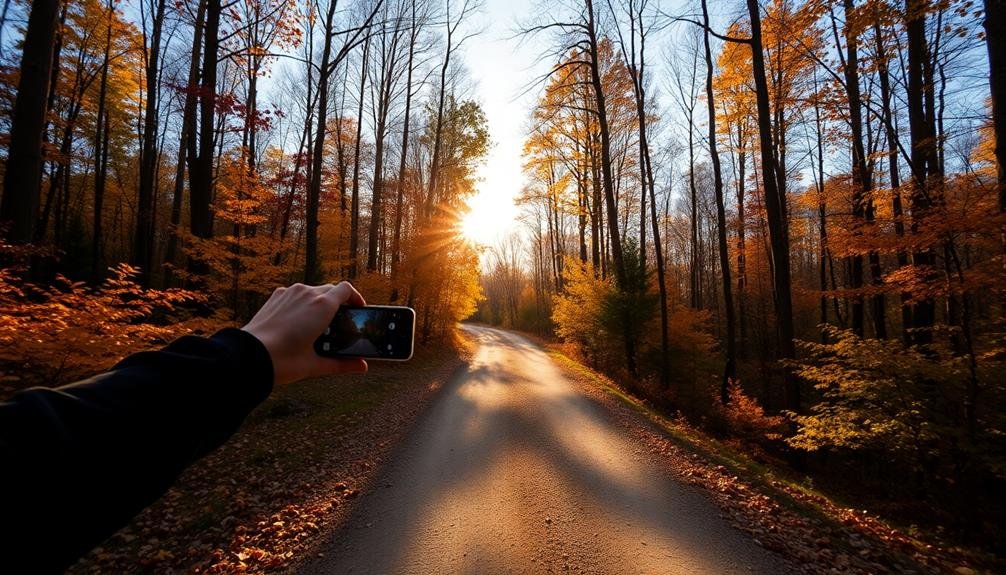
Where can you find leading lines in everyday scenes? They're all around you, waiting to be discovered. Look for roads, pathways, and sidewalks that stretch into the distance. These create powerful linear elements that draw the eye through your composition.
Fences, railings, and bridges offer strong horizontal or diagonal lines that can guide viewers' attention.
In urban environments, you'll find an abundance of architectural lines. Skyscrapers, staircases, and rows of windows provide vertical lines that add depth and structure to your images.
Don't overlook the subtle lines in nature, such as tree trunks, riverbanks, or mountain ridges. Even shadows cast by objects can create intriguing leading lines.
Pay attention to repeating patterns in your surroundings. Rows of street lamps, telephone poles, or parked cars can form compelling lines.
When you're indoors, look for bookshelves, hallways, or ceiling beams. Train your eye to spot these natural lines, and you'll start seeing photographic opportunities everywhere.
Create Depth With Roads
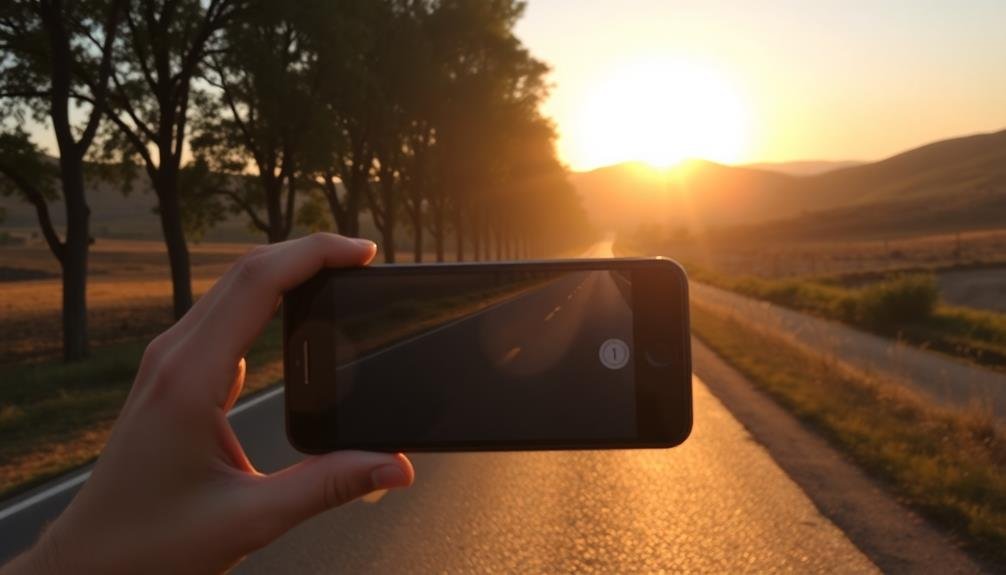
Roads offer some of the most powerful leading lines in photography, especially for creating a sense of depth. When you're out with your smartphone, look for straight or winding roads that stretch into the distance. These natural lines draw the viewer's eye into the image, creating a strong three-dimensional effect.
To capture the road's leading lines effectively, position yourself in the center or off to one side. Experiment with different angles to find the most compelling composition. Try crouching down low to emphasize the road's perspective, or shoot from an elevated position for a unique view.
Use the road's edges, lane markings, or even roadside features like guardrails or trees to enhance the leading lines. In urban settings, incorporate streetlights or buildings along the road to add interest. For rural scenes, capture the contrast between the road and surrounding landscape.
Don't forget to reflect on the time of day and lighting conditions. Early morning or late afternoon light can cast long shadows across the road, intensifying the leading lines. In rainy conditions, wet roads can reflect light and create additional lines to guide the viewer's gaze.
Use Architecture and Buildings
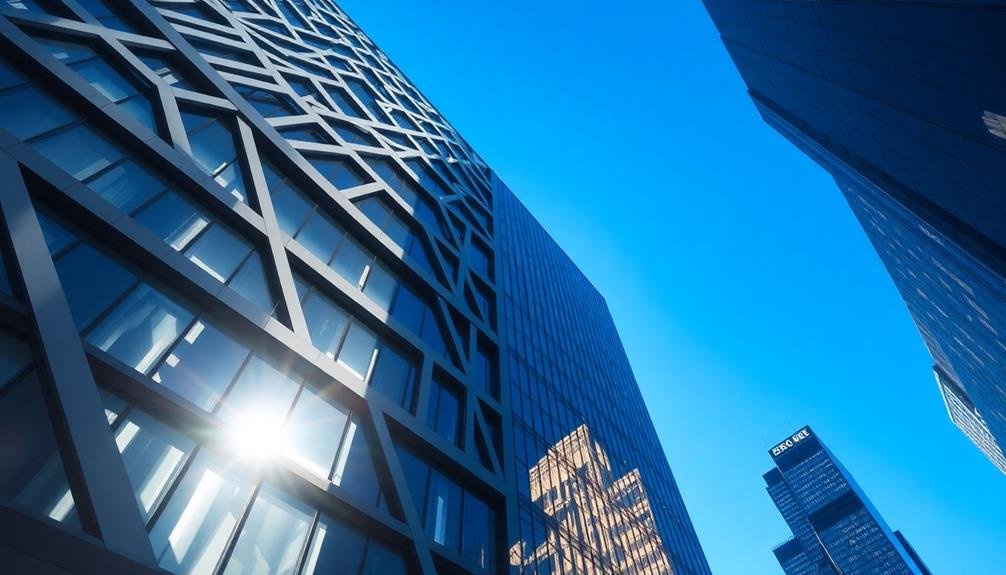
Architectural elements provide a wealth of opportunities for creating powerful leading lines in smartphone photography. Buildings, bridges, and urban structures offer a variety of shapes and patterns that can guide the viewer's eye through your composition.
Look for strong vertical lines in skyscrapers, horizontal lines in rows of windows, or diagonal lines in staircases and ramps. When shooting buildings, position yourself at an angle to capture converging lines that draw the eye to a focal point.
Use the edges of a building to frame your subject or create a sense of depth. Symmetry in architecture can also create compelling leading lines; try capturing the reflection of a building in water or glass for a mesmerizing effect.
Don't overlook smaller architectural details like railings, columns, or arches. These elements can create subtle yet effective leading lines that add interest to your composition.
Experiment with different perspectives: get low to emphasize the towering nature of buildings or shoot from above to capture patterns in rooftops and courtyards. By incorporating architectural elements as leading lines, you'll add structure and visual interest to your smartphone photos.
Leverage Shadows and Light
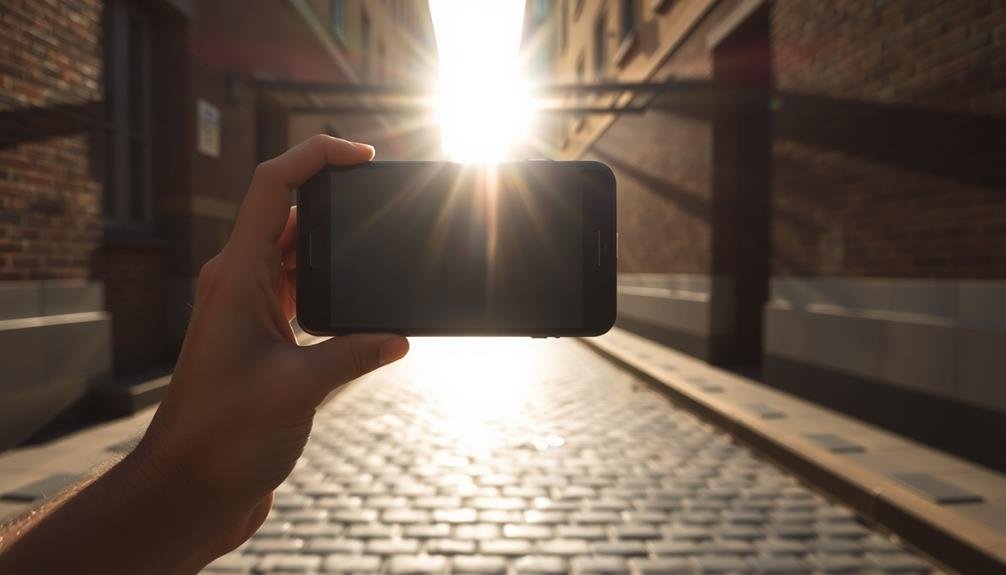
Shadows and light can be powerful tools for creating leading lines in your smartphone photography.
You'll find that dramatic contrasts between light and shadow can guide the viewer's eye through your image, while sunlight streaming through windows or gaps can form natural linear patterns.
At night, experiment with street lamps, car headlights, or illuminated buildings to craft compelling lines that draw attention to your subject.
Dramatic Contrast With Shadows
While leading lines can guide the eye, dramatic contrast with shadows can transform an ordinary scene into a fascinating composition. When using your smartphone camera, look for areas where light and shadow create stark differences. These contrasts often form their own leading lines, drawing attention to specific parts of your image.
To capture dramatic shadows, shoot during the golden hours of early morning or late afternoon when the sun is low. This creates long, bold shadows that can act as powerful leading lines. You'll find that architectural elements, trees, and even people can cast intriguing shadows that lead viewers through your photo.
Don't shy away from high-contrast scenes. Embrace the interplay between light and dark areas to create depth and dimension. Use your smartphone's exposure controls to emphasize these contrasts.
You can also experiment with black and white filters to further accentuate the shadow lines.
Sunlight Creating Linear Patterns
Natural sunlight is a powerful tool for creating striking linear patterns in smartphone photography. You can leverage the sun's position to cast shadows and create intriguing lines that guide the viewer's eye through your image. Look for architectural elements, fences, or even tree branches that cast long shadows across surfaces. Experiment with different times of day to capture varying shadow lengths and intensities.
To maximize the impact of sunlight-created lines, position yourself to capture the shadows at interesting angles. Try shooting from low angles or directly above to emphasize the linear patterns. Use your smartphone's exposure controls to guarantee the shadows aren't too dark or the highlights aren't blown out. Consider using HDR mode to capture a wider dynamic range in high-contrast scenes.
| Time of Day | Shadow Characteristics | Emotional Impact |
|---|---|---|
| Early Morning | Soft, Long | Peaceful, Mysterious |
| Midday | Short, Sharp | Intense, Dramatic |
| Late Afternoon | Warm, Extended | Nostalgic, Romantic |
| Golden Hour | Golden, Stretched | Magical, Dreamy |
| Blue Hour | Fading, Subtle | Calm, Ethereal |
Remember to experiment with different compositions and subjects to find unique ways of incorporating sunlight-created linear patterns into your smartphone photography.
Nighttime Illumination Techniques
As the sun sets, a new world of photographic opportunities emerges for smartphone users. Nighttime illumination techniques can create striking leading lines in your photos, guiding viewers' eyes through the image.
You'll find that streetlights, car headlights, and neon signs become powerful tools for composing engaging shots. To capture these illuminated lines effectively, experiment with long exposure settings on your smartphone. Many modern devices offer this feature, allowing you to create light trails from moving vehicles or emphasize the glow of stationary lights.
Position yourself at busy intersections or along well-lit streets to maximize these effects. Don't overlook the potential of artificial light sources indoors. Hallways with evenly spaced ceiling lights or staircases with integrated LEDs can produce compelling linear patterns.
When shooting, lower your phone's exposure compensation to enhance the contrast between light and shadow, making the leading lines more prominent. Remember to use reflective surfaces like wet pavement or glass buildings to your advantage.
These can double the impact of light sources, creating mirrored leading lines that add depth and intrigue to your nighttime compositions.
Incorporate Fences and Railings

Fences and railings can be powerful tools in your smartphone photography arsenal.
You'll find these structures offer ready-made leading lines to frame your subjects effectively and guide your viewer's gaze through the image.
Frame Subjects Effectively
In addition to guiding the viewer's eye, leading lines can effectively frame your subject when you incorporate fences and railings into your smartphone photos. Use these structures to create a natural border around your main subject, drawing attention to it while adding depth and context to your composition.
When framing with fences or railings, position your subject within the boundaries they create. You can place them centrally or use the rule of thirds for a more dynamic composition. Experiment with different angles and perspectives to find the most compelling frame.
Consider these framing techniques:
| Technique | Effect | Best For |
|---|---|---|
| Foreground Frame | Creates depth | Landscapes |
| Symmetrical Frame | Adds balance | Architecture |
| Partial Frame | Adds intrigue | Portraits |
Don't be afraid to get close to the fence or railing, using it to fill a larger portion of your frame. This can create a sense of intimacy or confinement, depending on your subject matter. Remember to focus on your subject, not the framing element, to guarantee it remains the star of your image. By mastering this technique, you'll add a new dimension to your smartphone photography, creating more engaging and visually appealing images.
Guide Viewer's Gaze
Through strategic placement of fences and railings, you can guide your viewer's gaze within your smartphone photos. These structures naturally create strong leading lines that draw attention to specific areas of your image. When you encounter a fence or railing, position yourself to align it with your intended focal point. Use the lines to lead the eye from the foreground to the background, creating depth and visual interest.
Try different angles to maximize the impact of these elements. A low angle shot can make a fence appear to stretch endlessly into the distance, while a side view might create a sense of rhythm and repetition. Don't be afraid to get close to these structures, as their patterns and textures can add intrigue to your composition.
Remember that fences and railings don't always have to be straight. Curved or winding structures can create a more dynamic flow in your image. Experiment with partial views, too. You don't need to include the entire fence or railing; sometimes, a section is enough to suggest direction and guide the viewer's eye effectively.
Utilize Reflections in Water
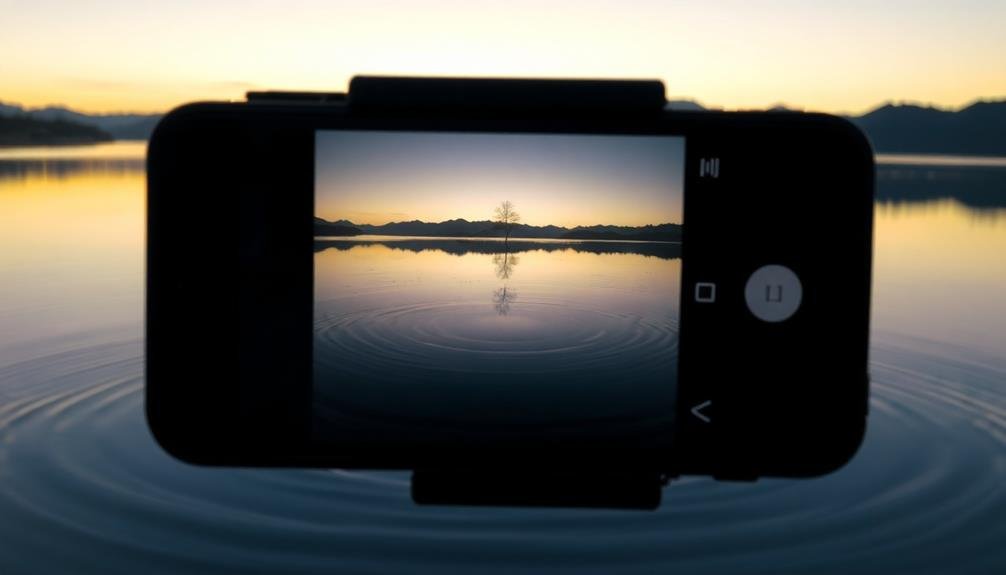
Reflections in water offer a unique opportunity to create compelling leading lines in your smartphone photography. When you encounter bodies of water like lakes, ponds, or even puddles, look for objects that cast reflections. These reflections can form strong, symmetrical lines that draw the viewer's eye into your image.
To capture effective water reflections, position yourself at a low angle near the water's edge. This perspective will maximize the reflection's visibility and impact. Calm water surfaces work best, as they create clearer, more defined reflections. Early mornings or evenings often provide ideal conditions with still water and soft light.
Try incorporating architectural elements like bridges, piers, or buildings that have strong vertical or horizontal lines. Their reflections will create a mirror image, doubling the impact of the leading lines. You can also use natural elements such as trees, mountains, or rock formations to achieve similar effects.
Experiment with partial reflections or rippled water surfaces to add an abstract quality to your images. These distorted reflections can create intriguing, curved leading lines that guide the viewer's gaze in unexpected ways.
Frame With Tree Branches
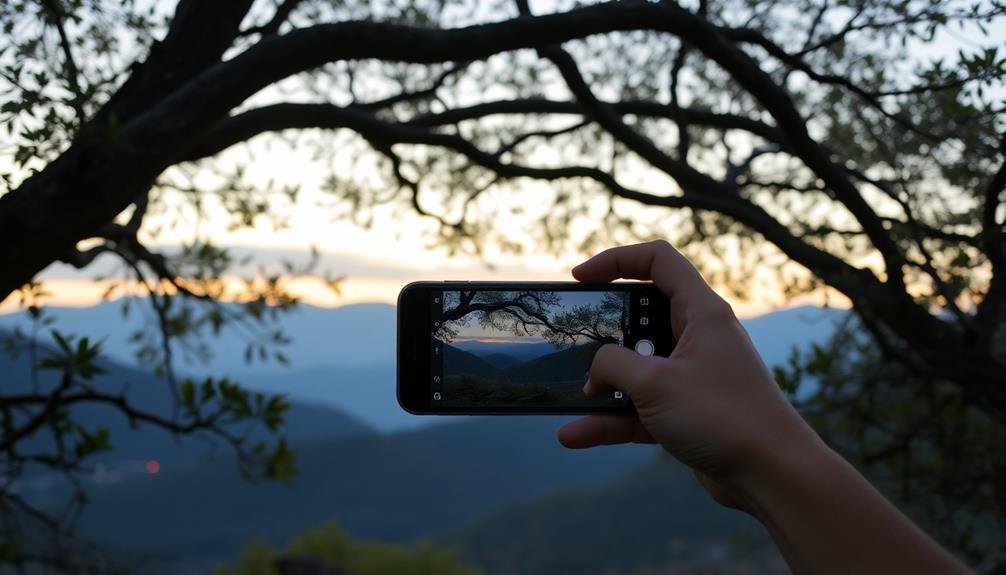
Have you ever considered using tree branches as natural frames for your smartphone photos? This technique can add depth and interest to your images, drawing the viewer's eye to your main subject.
To use tree branches effectively, look for opportunities where they naturally frame your scene. Position yourself so that branches create a border around your subject. You can frame just the top, sides, or create a full frame. Experiment with different angles and distances to find the most pleasing composition.
Remember, you don't need to include entire branches; even partial ones can create an effective frame. Pay attention to the negative space between branches, as this can create interesting shapes that complement your subject.
Try focusing on your main subject while allowing the branches to remain slightly blurred, creating a sense of depth. When framing with branches, be mindful of lighting. Backlighting can create striking silhouettes, while side lighting can add texture and dimension.
Don't be afraid to move around to find the best light and branch arrangement. With practice, you'll develop an eye for spotting these natural framing opportunities, enhancing your smartphone photography skills.
Frequently Asked Questions
What Camera Settings Are Best for Capturing Leading Lines?
You'll want to use a narrow aperture (high f-number) for deeper depth of field. Set a low ISO to reduce noise. Use a slower shutter speed if needed, but stabilize your camera. Focus on the leading line itself.
Can Leading Lines Be Effective in Portrait Photography?
Yes, leading lines can be incredibly effective in portrait photography. You'll find they draw attention to your subject, create depth, and add visual interest. Try using roads, fences, or architectural elements to guide the viewer's eye.
How Can I Emphasize Leading Lines During Post-Processing?
You can emphasize leading lines during post-processing by adjusting contrast, brightness, and saturation along the lines. Use selective editing tools to enhance their clarity. You can also crop the image to strengthen the lines' impact.
Are There Any Apps Specifically Designed for Leading Line Composition?
While there aren't many apps specifically for leading lines, you'll find composition grids in most camera apps. Try VSCO, Camera+ 2, or ProCam for advanced grid options. These tools will help you align and enhance leading lines effectively.
What's the Ideal Focal Length for Photographing Leading Lines With Smartphones?
For smartphone leading line photography, you'll find a wide-angle lens (around 24-28mm equivalent) works best. It'll capture more of the scene, emphasizing the lines. However, don't be afraid to experiment with different focal lengths for varied effects.
In Summary
You've now got seven powerful techniques to elevate your smartphone photography using leading lines. By incorporating these methods, you'll create more dynamic, engaging images that draw viewers in. Remember, leading lines are all around you – in nature, architecture, and even light and shadow. Keep your eyes open for these compositional elements, and don't be afraid to experiment. With practice, you'll soon be capturing stunning photos that guide the eye and tell a story.

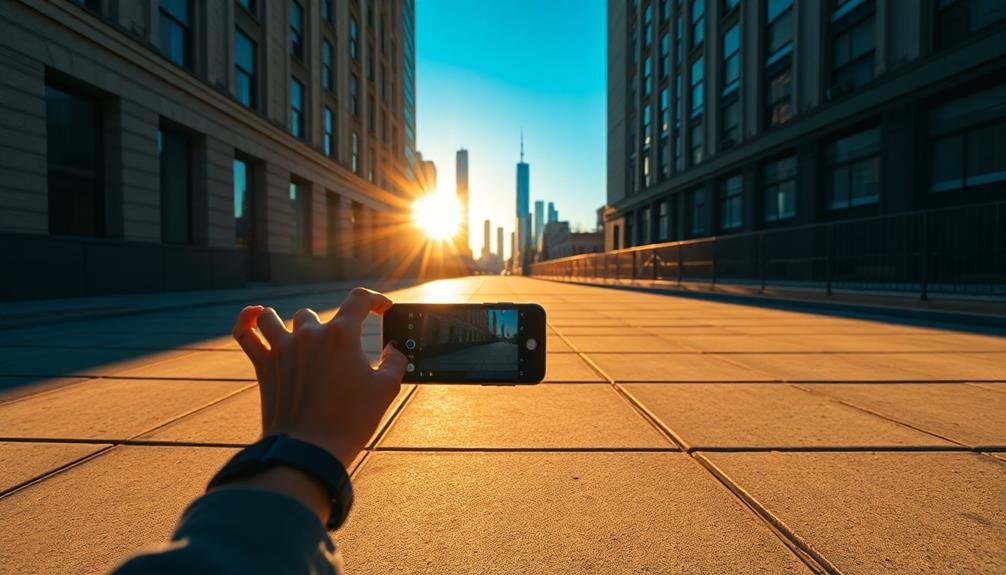



Leave a Reply